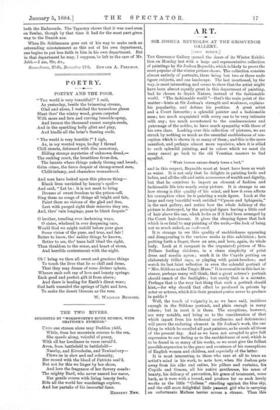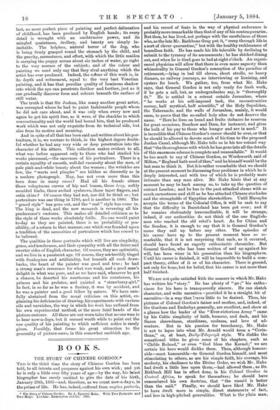ART.
SIR JOSHUA REYNOLDS AT THE GROSVENOR GALLERY. [FIRST NOTICE.]
THE Grosvenor Gallery opened the doors of its Winter Exhibi- tion on Monday last with a large and representative collection of paintings by Sir Joshua Reynolds, which is likely to prove the most popular of the winter picture shows. The collection consists almost entirely of portraits, there being but two or three nude figure subjects, and one landscape. The last mentioned, by the way, is most interesting, and seems to show that the artist might have been almost equally great in this department of painting, bad he chosen to depict Nature, instead of the fashionable world. " The fashionable world "—that's the main point of the matter—hints at Sir Joshua's strength and weakness, explains his popularity, and defines his position. A great artist and a Court favourite ; a splendid painter and a fashionable man ; too much acquainted with every one to be very intimate with any ; too much accustomed to the condescensions and patronage of the nobles, to have mach sympathy with those of his own class. Looking over this collection of 'pictures, we are struck by nothing so much as the essential snobbishness of con- ception which is shown in so many of them ; and this is the more manifest, and perhaps almost more repulsive, when it is allied to such splendid painting, and to colour which we must (in many cases) go back to the old Venetian masters to find (Quailed.
" Weak human nature dearly loves a lord,"
and in this respect, Reynolds must at heart have been as weak as water. It is not only that he delights in painting lords and ladies, and all the silk and satin accessories of wealth and dignity, but that he contrives to import an element of fashion and fashionable life into nearly every picture. It is strange to see how strong is this quality of his mind, and how it even affects his conception when he is painting a nude figure. Look at the large and very beautiful work entitled " Cymon and Iphigenia," in the east gallery, and notice how the whole delicacy of the picture is destroyed, by the principal figure having a little curl of hair above the ear, which looks as if it had been arranged by the Court hair-dresser. It gives the sleeping figure that look which is so fatal to any painting of the nude,—the look of being not so much naked, as undressed.
It is strange to see this quality of snobbishness appearing and disappearing in the various works in this exhibition ; here putting forth a finger, there an arm, and here, again, its whole body. Look at it rampant in the (repainted) picture of Mrs. Pelham feeding chickens, in a sham simplicity of print dress and muslin apron ; mark it in the Cupids putting on elaborately frilled caps, or playing with paint-brushes ; and watch its last faint reflection in even the splendid portrait of " Mrs. Siddons as the Tragic Muse." It is excusable in this last in- stance, perhaps many will think, that a great actress's portrait should smack of the footlights ; but surely that is a mistake. Perhaps that is the very last thing that such a portrait should hint,—for why should that effect be produced in private by actor or actress, which it is their greatest praise never to produce in public ?
Well, the touch of vulgarity is, as we have said, insidious enough in the Siddons portrait, and plain enough in many others ; but in most it is there. The exceptions, however, are very notable, and bring us to the consideration of that which (apart from his technical excellencies and deficiencies) will prove the enduring element in Sir Joshua's work, the one thing in which he excelled all past painters, as he excels all those of the present day. And as we have not scrupled to give full expression to our feeling as to the snobbishness of soul, which is to be found in so many of his works, so we must give the fullest possible expression to the grace and sweetness of his conceptions of English women and children, and especially of the latter.
It is most interesting, to those who care at all to trace an artist's mind in his work, to note how, when Sir Joshua gets away from his silks and satins, his pillars and curtains, his Cupids and Graces, all his native gentleness, his sense of beauty, his delicacy of perception, his grace of treatment, come back, as it were with a bound, and produce for us such lovely works as the little " Colleen " standing against the blue sky, and the still more delightful little peasant girl who is carrying an unfortunate Maltese terrier across a stream. Than this
last, no more perfect piece of painting and perfect delineation of childhood, has been produced by English hands; its every detail is wrought with an unobtrusive power, and its mingled quaintness, drollery, and beauty are simply in- imitable. The helpless, natural terror of the dog, who is being firmly grasped round the stomach by the child, and the gravity, earnestness, and effort, with which the little maiden is carrying the puppy across about six inches of water, go right to the very essence of the subject; and of the colour and painting we need only say that they rival anything which the artist has ever produced. Indeed, the cotour of this work is, in its depth and refinement, equal to the very best Venetian painting, and it has that peculiar quality of luminous shadow into which the eye can penetrate further and farther, just as it can gradually discover form and colours beneath the surface of still water.
The truth is that Sir Joshua, like many another great artist, was corrupted where he had to paint fashionable people whom he did not care about, and it was only when every now and again he got his spirit free, as it were, of the shackles in which conventionality and the world had bound him, that he produced work which was not only exquisite from its technical side, but also from its motive and meaning.
And in spite of all that has been said and written about his por- traiture, it is, we venture to think, in the highest degree doubt- ful whether he had any very wide or deep penetration into the
character of his sitters. This collection makes evident to all, what was before apparent only to those who had studied his works piecemeal,—the sameness of his portraiture. There is a certain equality of smooth, well-fed va,cnosity about the men, of pale pink-and-white beauty about the women ; the wrinkles are few, the " warts and pimples " are hidden as discreetly as in a modern photograph. Nay, has not even more than this been done in many cases P Had all his female sitters those voluptuous carves of hip and bosom, those long, softly moulded limbs, those arched eyebrows, those taper fingers, and satin skins P Of course they had not, nor did he think so ; but portraiture was one thing in 1780, and is another in 1880. The " grand style" has gone out, and the " real " style has come in. The king is dead, and the new monarch is reversing all his predecessor's customs. This makes all detailed criticism as to the style of these works absolutely futile. No one would paint to-day as they are painted, there is no probability or pos- sibility, of a return to that manner, one which was founded upon a tradition of the necessities of portraiture which has ceased to be believed.
The qualities in these portraits which will live are simplicity, grace, and tenderness, and their sympathy with all the fairer and sweeter sides of English character. Of course, they are optimistic, and we live in a pessimist age. Of course, they are terribly tinged with flunkeyism and artificiality, but beneath all such draw- backs, the heart of the painter was good and true ; he had a strong man's reverence for what was weak, and a good man's delight in what was pure, and as we have said, whenever he got a chance, he deserted his courtesans and his countesses, his princes and his prelates, and painted a " strawberry-girl." In fact, in so far as he was a flunkey, it was by accident, and he was a painter and a good fellow by nature. We have care- fully abstained from the usual criticism on this artist, ex- plaining his deficiencies of drawing, his experiments with various oils and varnishes, the way in which his work has suffered from his own experimental method, or the more fatal hands of the picture-restorer. AU these are oat-worn tales that no one wan is to hear now-a-days, but it seemed worth while to point out the one quality of his painting to which sufficient notice is rarely given. Possibly, that forms his great attraction to the generality of picture-seers, in this somewhat snobbish age.







































 Previous page
Previous page